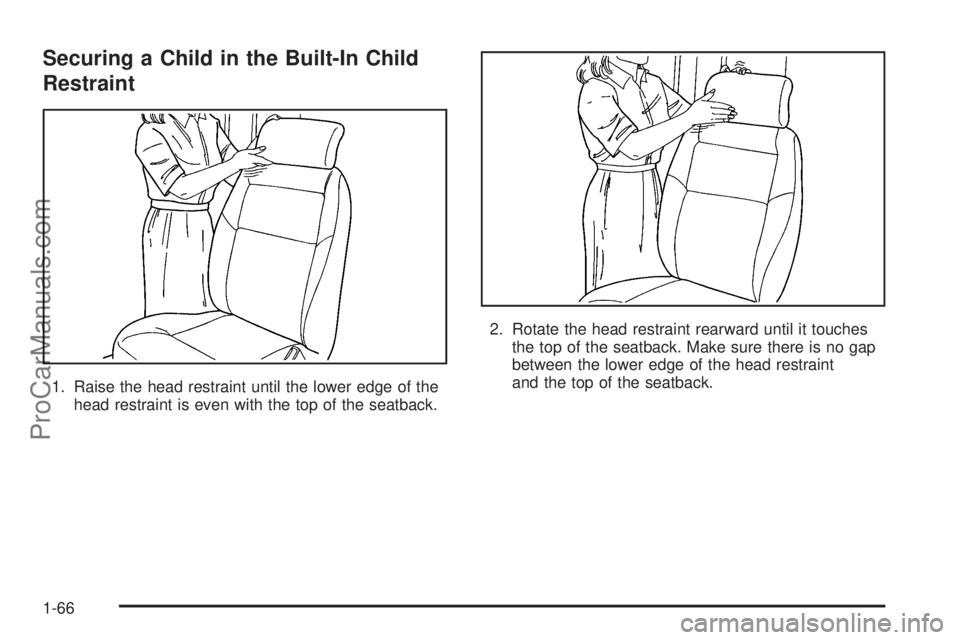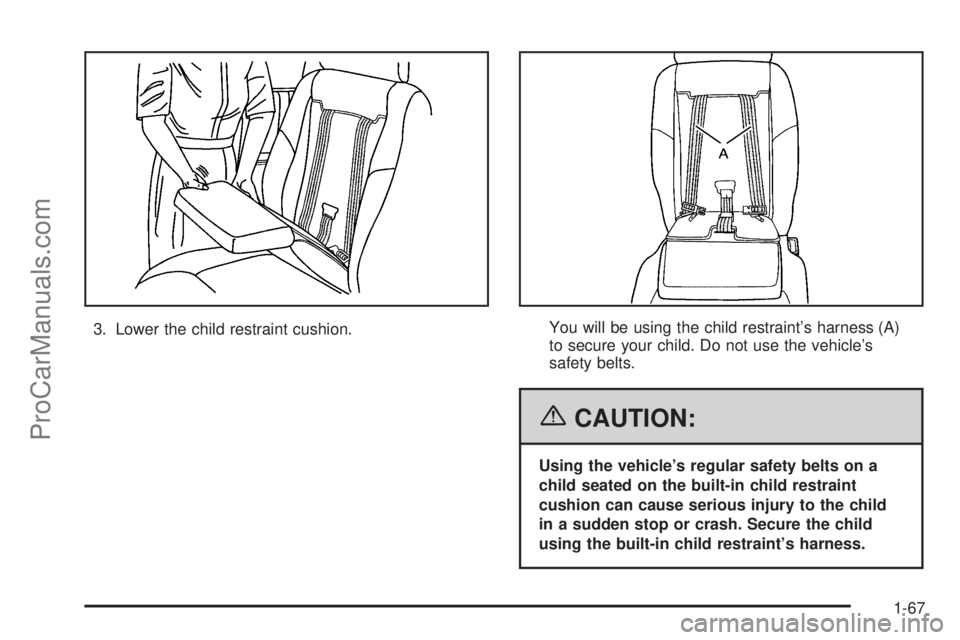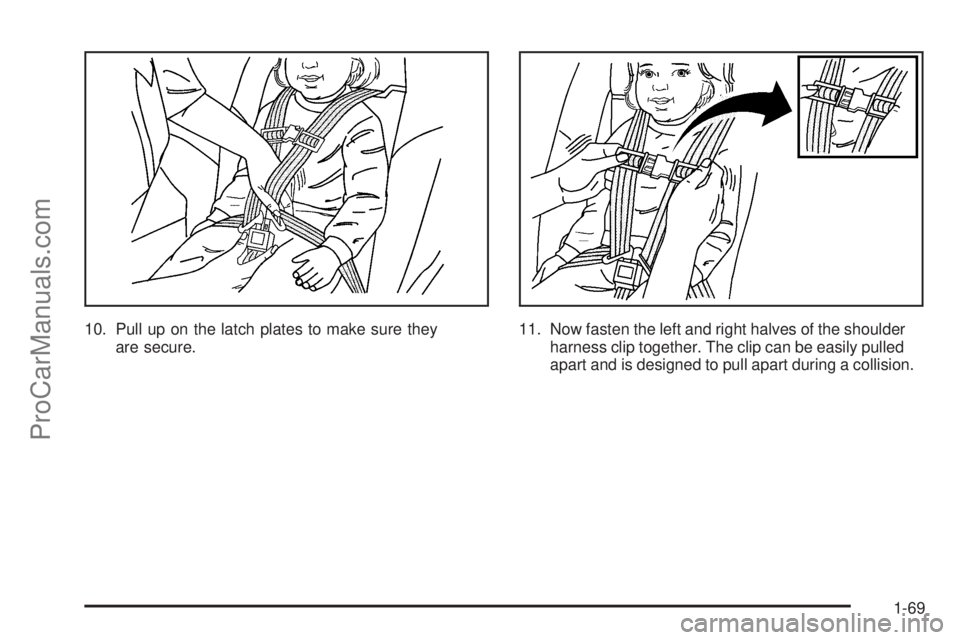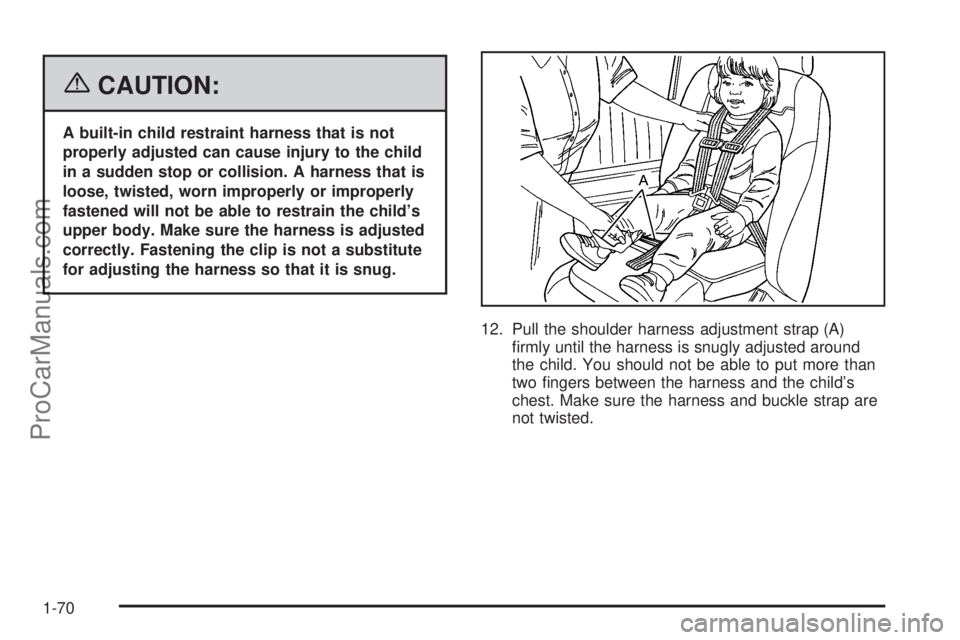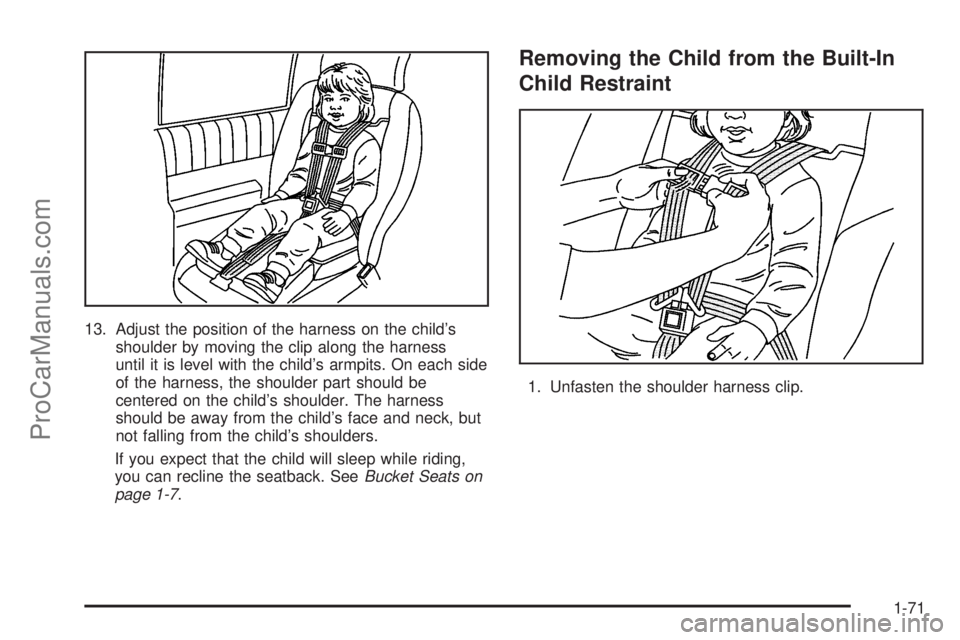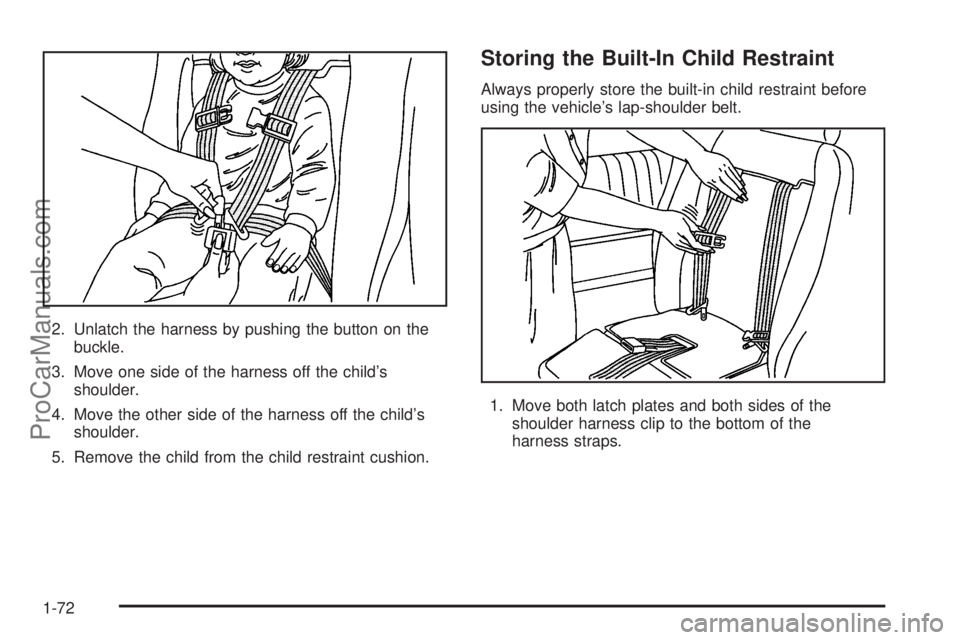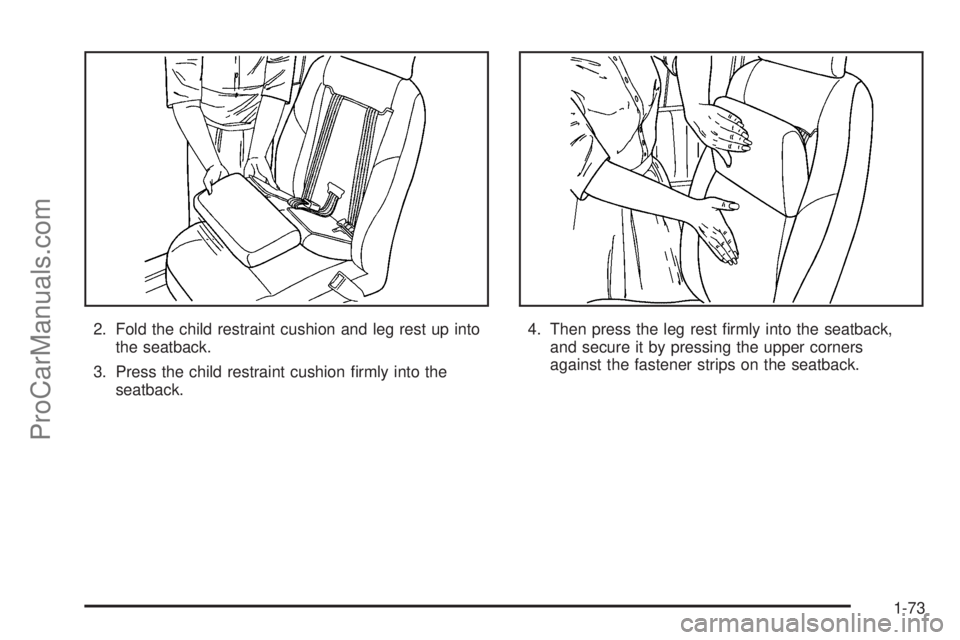CHEVROLET UPLANDER 2006 Manual PDF
UPLANDER 2006
CHEVROLET
CHEVROLET
https://www.carmanualsonline.info/img/24/57724/w960_57724-0.png
CHEVROLET UPLANDER 2006 Manual PDF
Trending: coolant reservoir, differential, jump start terminals, manual radio set, clock reset, instrument cluster, air conditioning
Page 71 of 458
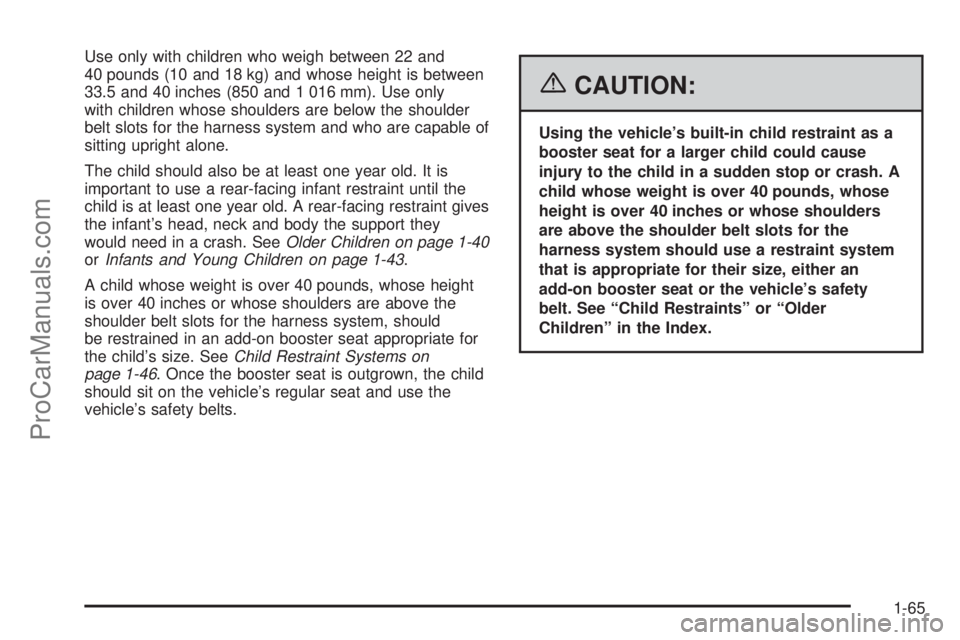
Use only with children who weigh between 22 and
40 pounds (10 and 18 kg) and whose height is between
33.5 and 40 inches (850 and 1 016 mm). Use only
with children whose shoulders are below the shoulder
belt slots for the harness system and who are capable of
sitting upright alone.
The child should also be at least one year old. It is
important to use a rear-facing infant restraint until the
child is at least one year old. A rear-facing restraint gives
the infant’s head, neck and body the support they
would need in a crash. SeeOlder Children on page 1-40
orInfants and Young Children on page 1-43.
A child whose weight is over 40 pounds, whose height
is over 40 inches or whose shoulders are above the
shoulder belt slots for the harness system, should
be restrained in an add-on booster seat appropriate for
the child’s size. SeeChild Restraint Systems on
page 1-46. Once the booster seat is outgrown, the child
should sit on the vehicle’s regular seat and use the
vehicle’s safety belts.
{CAUTION:
Using the vehicle’s built-in child restraint as a
booster seat for a larger child could cause
injury to the child in a sudden stop or crash. A
child whose weight is over 40 pounds, whose
height is over 40 inches or whose shoulders
are above the shoulder belt slots for the
harness system should use a restraint system
that is appropriate for their size, either an
add-on booster seat or the vehicle’s safety
belt. See “Child Restraints” or “Older
Children” in the Index.
1-65
ProCarManuals.com
Page 72 of 458
Securing a Child in the Built-In Child
Restraint
1. Raise the head restraint until the lower edge of the
head restraint is even with the top of the seatback.2. Rotate the head restraint rearward until it touches
the top of the seatback. Make sure there is no gap
between the lower edge of the head restraint
and the top of the seatback.
1-66
ProCarManuals.com
Page 73 of 458
3. Lower the child restraint cushion.You will be using the child restraint’s harness (A)
to secure your child. Do not use the vehicle’s
safety belts.
{CAUTION:
Using the vehicle’s regular safety belts on a
child seated on the built-in child restraint
cushion can cause serious injury to the child
in a sudden stop or crash. Secure the child
using the built-in child restraint’s harness.
1-67
ProCarManuals.com
Page 74 of 458
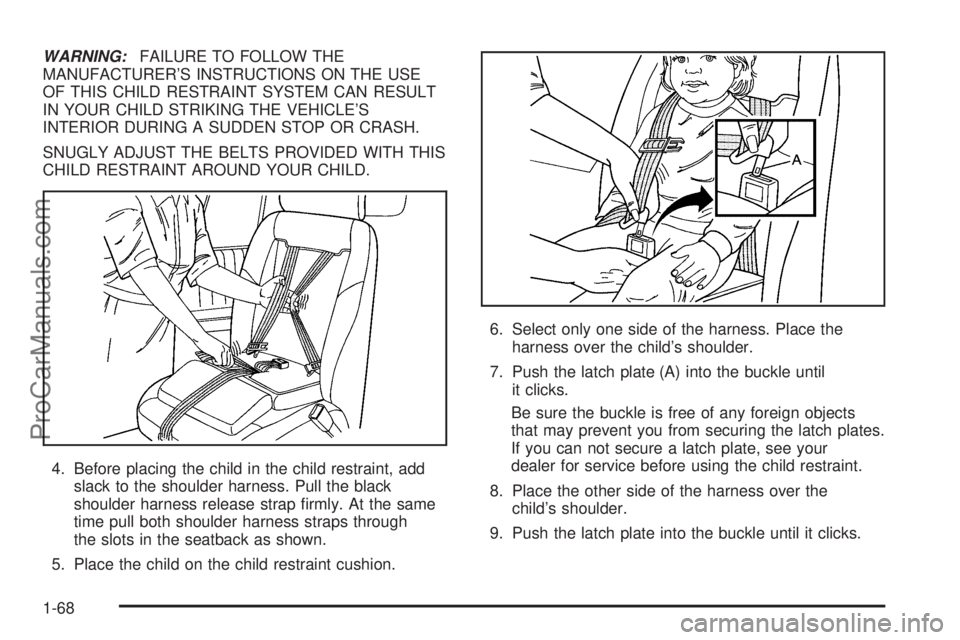
WARNING:FAILURE TO FOLLOW THE
MANUFACTURER’S INSTRUCTIONS ON THE USE
OF THIS CHILD RESTRAINT SYSTEM CAN RESULT
IN YOUR CHILD STRIKING THE VEHICLE’S
INTERIOR DURING A SUDDEN STOP OR CRASH.
SNUGLY ADJUST THE BELTS PROVIDED WITH THIS
CHILD RESTRAINT AROUND YOUR CHILD.
4. Before placing the child in the child restraint, add
slack to the shoulder harness. Pull the black
shoulder harness release strap �rmly. At the same
time pull both shoulder harness straps through
the slots in the seatback as shown.
5. Place the child on the child restraint cushion.6. Select only one side of the harness. Place the
harness over the child’s shoulder.
7. Push the latch plate (A) into the buckle until
it clicks.
Be sure the buckle is free of any foreign objects
that may prevent you from securing the latch plates.
If you can not secure a latch plate, see your
dealer for service before using the child restraint.
8. Place the other side of the harness over the
child’s shoulder.
9. Push the latch plate into the buckle until it clicks.
1-68
ProCarManuals.com
Page 75 of 458
10. Pull up on the latch plates to make sure they
are secure.11. Now fasten the left and right halves of the shoulder
harness clip together. The clip can be easily pulled
apart and is designed to pull apart during a collision.
1-69
ProCarManuals.com
Page 76 of 458
{CAUTION:
A built-in child restraint harness that is not
properly adjusted can cause injury to the child
in a sudden stop or collision. A harness that is
loose, twisted, worn improperly or improperly
fastened will not be able to restrain the child’s
upper body. Make sure the harness is adjusted
correctly. Fastening the clip is not a substitute
for adjusting the harness so that it is snug.
12. Pull the shoulder harness adjustment strap (A)
�rmly until the harness is snugly adjusted around
the child. You should not be able to put more than
two �ngers between the harness and the child’s
chest. Make sure the harness and buckle strap are
not twisted.
1-70
ProCarManuals.com
Page 77 of 458
13. Adjust the position of the harness on the child’s
shoulder by moving the clip along the harness
until it is level with the child’s armpits. On each side
of the harness, the shoulder part should be
centered on the child’s shoulder. The harness
should be away from the child’s face and neck, but
not falling from the child’s shoulders.
If you expect that the child will sleep while riding,
you can recline the seatback. SeeBucket Seats on
page 1-7.
Removing the Child from the Built-In
Child Restraint
1. Unfasten the shoulder harness clip.
1-71
ProCarManuals.com
Page 78 of 458
2. Unlatch the harness by pushing the button on the
buckle.
3. Move one side of the harness off the child’s
shoulder.
4. Move the other side of the harness off the child’s
shoulder.
5. Remove the child from the child restraint cushion.
Storing the Built-In Child Restraint
Always properly store the built-in child restraint before
using the vehicle’s lap-shoulder belt.
1. Move both latch plates and both sides of the
shoulder harness clip to the bottom of the
harness straps.
1-72
ProCarManuals.com
Page 79 of 458
2. Fold the child restraint cushion and leg rest up into
the seatback.
3. Press the child restraint cushion �rmly into the
seatback.4. Then press the leg rest �rmly into the seatback,
and secure it by pressing the upper corners
against the fastener strips on the seatback.
1-73
ProCarManuals.com
Page 80 of 458
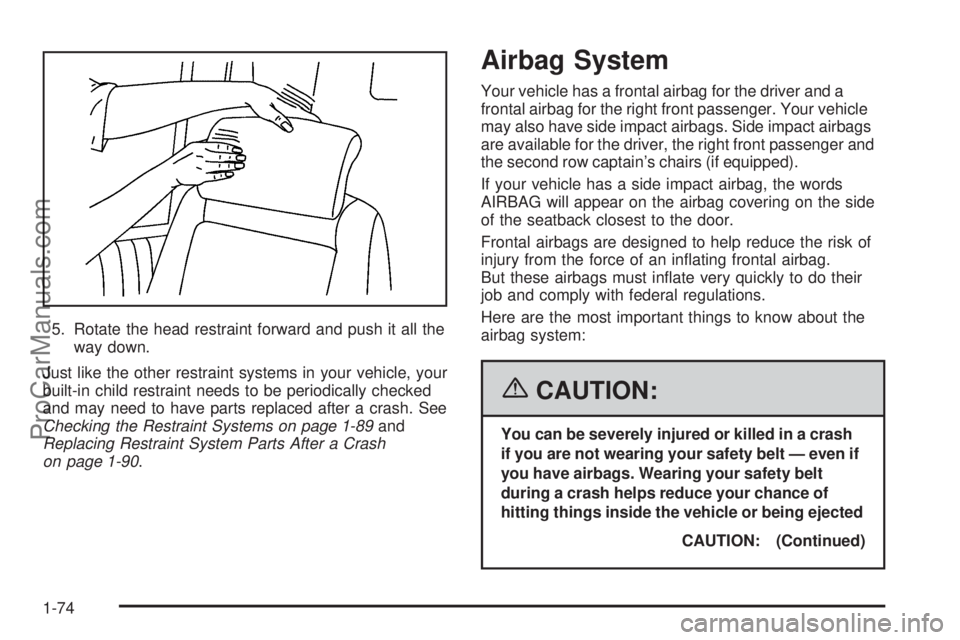
5. Rotate the head restraint forward and push it all the
way down.
Just like the other restraint systems in your vehicle, your
built-in child restraint needs to be periodically checked
and may need to have parts replaced after a crash. See
Checking the Restraint Systems on page 1-89and
Replacing Restraint System Parts After a Crash
on page 1-90.
Airbag System
Your vehicle has a frontal airbag for the driver and a
frontal airbag for the right front passenger. Your vehicle
may also have side impact airbags. Side impact airbags
are available for the driver, the right front passenger and
the second row captain’s chairs (if equipped).
If your vehicle has a side impact airbag, the words
AIRBAG will appear on the airbag covering on the side
of the seatback closest to the door.
Frontal airbags are designed to help reduce the risk of
injury from the force of an in�ating frontal airbag.
But these airbags must in�ate very quickly to do their
job and comply with federal regulations.
Here are the most important things to know about the
airbag system:
{CAUTION:
You can be severely injured or killed in a crash
if you are not wearing your safety belt — even if
you have airbags. Wearing your safety belt
during a crash helps reduce your chance of
hitting things inside the vehicle or being ejected
CAUTION: (Continued)
1-74
ProCarManuals.com
Trending: wheel alignment, check engine light, brake pads, oil reset, wheel torque, engine, wheel size

